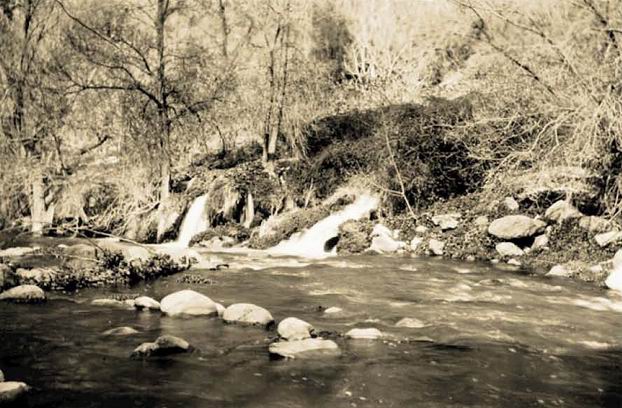
Remnants of the
The 12th (---) of Christmas
Hunt for the Flat Thomas 12" Suspension Insulator
(Published in the April 2004 issue of Crown Jewels)
By Carver Mead & Barbara Smith
[Carver and Barb have researched several early lines and made successful trips to each finding rare early porcelain insulators each time. The excitement they share for these hunts is extraordinary. Perhaps their greatest discovery was on the Kern-1 line where they found not just one M-4800, but M-4800's from three different manufacturers! Don't miss reading that story and their stories reproduced on this web site.]
It is December 2003, and the holidays are bearing down upon us. This is our 12th holiday season together, and it seems like a celebration is in order---something exciting and very romantic. Well, what could be more romantic than a hydroelectric project in the middle of a desert, where almost no rain ever falls?

Fossil Springs gushes forth its mineral-laden water on a high plateau in central Arizona. Its temperature is 72 degrees, and its flow rate is 43 cubic feet per second, winter and summer, year after year. Ten miles away, the Verde River has cut a gorge 1600 feet deep into the plateau. In 1900, rancher Lew Turner filed the first claim to the water for hydroelectric use. In 1903, the Los Angeles Herald reported that Mrs. Iva Tutt of Los Angeles was “engaged in a three million dollar enterprise in Arizona. The erection of two electric power plants to supply power exclusively for mining purposes … She contracted for water rights, took out her engineering party, following the transit every step of the way back into the mountains where few men and no woman had ever gone before, to the head of Fossil Creek, returning with all plans formulated for the prosecution of the work.” Electrical Review called it “A Wonderful Water Power”.

It was not until 1907, however, that the Arizona Power Company was organized to pursue the development. On March 28, 1908, construction began on the first plant at Childs, on the Verde River, which would use 1100 feet of the total 1600 available. A 40-mile wagon road was constructed from Mayer, the nearest railroad station. The project required a water conduit 38,000 ft. in length composed of 10,000 ft. of concrete tunnels, 12,000 ft. of concrete flume, 2200 ft. of wood flume on trestles over gulches, 7500 ft. of steel gravity siphon, a reinforced concrete surge tank 36 ft. high and 30 ft. in diameter, and 4800 ft. of steel penstock pipe, made to hold 1100 ft. of head at its lower end. The power plant itself housed three 3000 H.P. impulse-wheel generators, each with its associated transformers and switches. A work force of 600 men backed by 400 mules pulling 150 wagons, completed construction in 12 months.
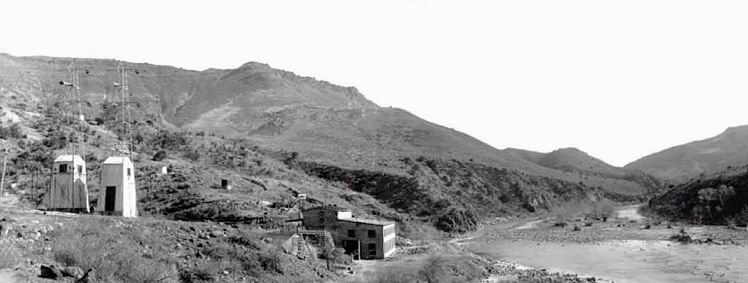
The original 45kV transmission line ran west
along the wagon road as far as Poland Junction. From there, one branch ran north to the rich mining area at
Jerome, where the United Verde Copper Co. had already contracted for more than
one-third of the total generating capacity.
A second branch ran northwest to Walker and Prescott.
Electrical World, Aug. 25,
1910, gave the following description: “The transmission line is composed of
steel towers, 45 ft. high with three wires in a vertical plane, on each side of
the towers and a steel messenger wire for lightening protection running over the
peak.”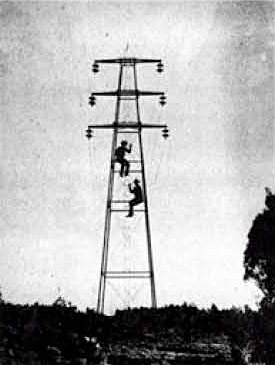
“Double Thomas 15-in. hook-and-eye type insulators are used. Thirty-five miles of the line is composed of No. 1 B. & S. seven-strand wire. The two branches 16 and 24 miles respectively from the junction are composed of No. 4 B. & S. three-strand wire running to Prescott and Jerome.”
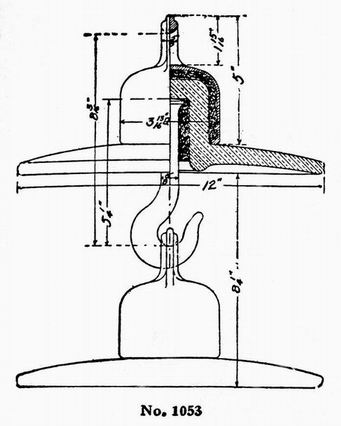
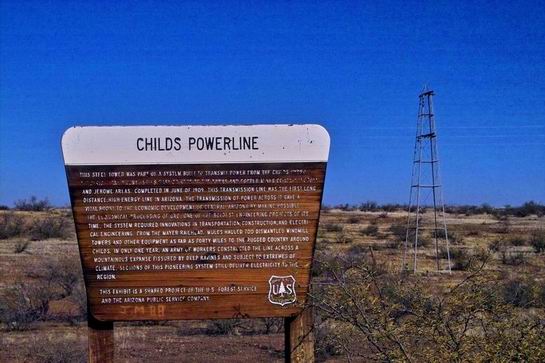 This is a memorial to the Childs Power Line,
sitting there like a gravestone. The
sign reads: “This steel tower was
part of a system built to transmit power from the Childs hydroelectric plant
twenty miles east of here to the towns and copper mines of the Prescott and
Jerome areas. Completed in June of
1909, this transmission line was the first long distance, high energy line in
Arizona. The transmission of power
across it gave a vital boost to the economic development of central Arizona by
making possible the economical processing of ore. One of the boldest engineering projects of its time, the
system required innovations in transportation, construction, and electrical
engineering. From the Mayer
railhead, mules hauled 700 dismantled windmill towers and other equipment as far
as forty miles to the rugged country around Childs. In only one year, an
army of workers constructed the line across a mountainous expanse fissured by
deep ravines and subject to extremes of climate.
Sections of this pioneering system still deliver electricity to the
region.”
This is a memorial to the Childs Power Line,
sitting there like a gravestone. The
sign reads: “This steel tower was
part of a system built to transmit power from the Childs hydroelectric plant
twenty miles east of here to the towns and copper mines of the Prescott and
Jerome areas. Completed in June of
1909, this transmission line was the first long distance, high energy line in
Arizona. The transmission of power
across it gave a vital boost to the economic development of central Arizona by
making possible the economical processing of ore. One of the boldest engineering projects of its time, the
system required innovations in transportation, construction, and electrical
engineering. From the Mayer
railhead, mules hauled 700 dismantled windmill towers and other equipment as far
as forty miles to the rugged country around Childs. In only one year, an
army of workers constructed the line across a mountainous expanse fissured by
deep ravines and subject to extremes of climate.
Sections of this pioneering system still deliver electricity to the
region.”
Carver is muttering some choice unprintable comments about anyone who would tear down a steel tower line and replace it with wood poles. There is hope, however: The sign indicates that some sections of the line are still in service. We’ll have to find out which ones. Driving farther down the wagon road yields nothing except more wood poles. It is probably like every other historic line we have explored: We’ll only find original stuff in the most rugged, remote, inaccessible places. So we head for the mountains.